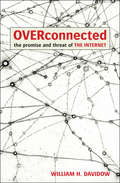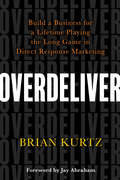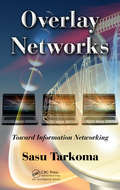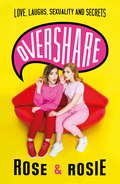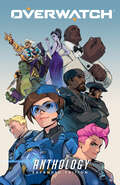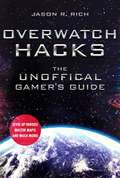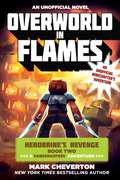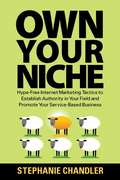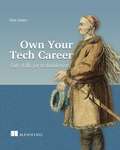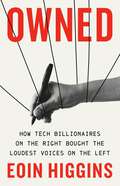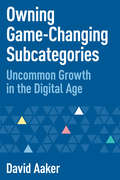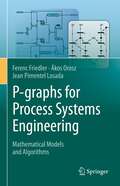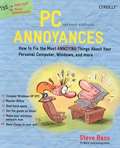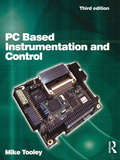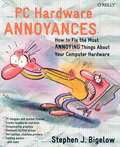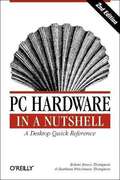- Table View
- List View
Overconnected: The Promise and Threat of the Internet
by William H. Davidow&“Shows how the unanticipated effects of the Internet are distorting economics, politics, international relations, and individual lives&” (James Fallows). In Overconnected, Bill Davidow, a former Silicon Valley executive, explains how the almost miraculous success of the Internet has also created a unique set of hazards, in effect overconnecting us, with the direst of consequences for our political, economic, and day-to-day lives. The practical applications—not least among them the ability to borrow money, invest in the stock market, or buy a new home—have made a great impact in our daily lives. But the luxuries of the connected age have taken on a momentum all of their own, ultimately becoming the root cause of a financial meltdown from which much of the world is now still struggling to recover. By meticulously and counter-intuitively anatomizing how being overconnected tends to create systems of positive feedback that have largely negative consequences, Davidow explains everything from the subprime-mortgage crisis to the meltdown of Iceland, from the loss of people&’s privacy to the spectacular fall of the stock market that forced the Federal Government to rescue institutions supposedly &“too big to fail.&” All because we were so miraculously wired together! Explaining how such symptoms of Internet connection as unforeseeable accidents and thought contagions acted to accelerate the downfall and make us permanently vulnerable to catastrophe, Davidow places our recent experience in historical perspective and offers a set of practical steps to minimize similar disasters in the future. Original, commonsensical and historically informed, Overconnected indentifies problems we live with that are now so large, omnipresent and part of our daily lives that few people have even noticed them.
Overdeliver: Build a Business for a Lifetime Playing the Long Game in Direct Response Marketing
by Brian KurtzBrian Kurtz is the bridge connecting the bedrock fundamentals of direct response marketing to the state-of-the-art strategies, tactics, and channels of today. Overdeliver distills his expertise from working in the trenches over almost four decades to help readers build a business that maximizes both revenue and relationships.Marketing isn't everything, according to Brian Kurtz.It's the only thing.If you have a vision or a mission in life, why not share it with millions instead of dozens?And while you are sharing it with as many people as possible and creating maximum impact, why not measure everything and make all of your marketing accountable?That's what this book is all about.In the world of direct marketing, Brian Kurtz has seen it all and done it all over almost four decades. And he lives by the philosophy, "Those who did it have a responsibility to teach it." Here's a small sample of what you'll learn: * The 4 Pillars of Being Extraordinary * The 5 Principles of why "Original Source" matters * The 7 Characteristics that are present in every world class copywriter * Multiple ways to track the metrics that matter in every campaign and every medium, online and offline * Why customer service and fulfillment are marketing functions * That the most important capital you own has nothing to do with money * And much moreWhether you're new to marketing or a seasoned pro, this book gives you a crystal-clear road map to grow your business, make more money, maximize your impact in your market, and love what you're doing while you're doing it. Kurtz takes you inside the craft to help you use all the tools at your disposal--from the intricate relationship between lists, offers, and copy, to continuity and creating lifetime value, to the critical importance of multichannel marketing and more--so you can succeed wildly, exceed all your expectations, and overdeliver every time.
Overhang Design Methods: Optimal Thermal and Daylighting Performance (SpringerBriefs in Architectural Design and Technology)
by Sanja StevanovicIt is estimated that windows in office buildings are responsible for one third of energy used for their heating and cooling. Designing window shading that balances often contradictory goals of preventing excessive heat gains in hot periods, without compromising beneficial heat gains in cold periods or visual comfort in indoor spaces of modern buildings with highly glazed facades, is an interesting multi-objective optimisation problem that represents an active research topic in the field of building energy and daylighting. Window overhangs are the simplest and most traditional shading devices that are easy to install, highly cost-effective, require low or no maintenance and offer unobstructed views outside. This book provides a review of overhang design methods for optimal thermal and daylighting performance. It starts with a historical overview of methods based on solar positions and shading masks. Next it discusses current research methodology, including shading calculation methods, ways of quantifying thermal and daylighting overhang effectiveness and the use of multi-objective optimisation approaches, together with the case studies that employ them. It further covers methods for designing innovative overhang types such as NURBS outlined overhangs and PV integrated dynamic overhangs. The appendix classifies published overhang case studies according to major climate type and latitude of their locations. As such, the book presents a valuable resource for understanding subtle nuances of interaction between solar radiation, shading devices and indoor comfort. The intended target audience are building energy researchers interested in optimisation of window shading devices.
Overlay Networks: Toward Information Networking.
by Sasu TarkomaWith their ability to solve problems in massive information distribution and processing, while keeping scaling costs low, overlay systems represent a rapidly growing area of R&D with important implications for the evolution of Internet architecture. Inspired by the author's articles on content based routing, Overlay Networks: Toward Information
Overshare: Love, Laughs, Sexuality and Secrets
by Rose Ellen Dix Rosie SpaughtonRose and Rosie are known for their candid and hilarious YouTube videos... but now they are taking oversharing to a whole new level. Discussing sexuality, revealing secrets and empowering others, OVERSHARE is a book packed with Rose and Rosie's unique take on friendships, fame, mental health and LGBT issues.As visibly out members of the LGBT community, they open up about their own experiences, both together and as individuals, and have written this book in the hope that it gives strength to those who have faced similar difficulties. They are spreading a message of positivity and inclusivity, and want everyone to feel comfortable in their own skin, no matter what their sexuality. Delve deep into the unfiltered highs and lows of Rose and Rosie's life: family relationships, secrets of a happy marriage, struggles with OCD and anxiety, finding love and navigating the world as a gay couple. Get ready to laugh, cry, cringe and OVERSHARE.
Overshare: Love, Laughs, Sexuality and Secrets
by Rose Ellen Dix Rosie SpaughtonRose and Rosie are known for their candid and hilarious YouTube videos... but now they are taking oversharing to a whole new level. Discussing sexuality, revealing secrets and empowering others, OVERSHARE is a book packed with Rose and Rosie's unique take on friendships, fame, mental health and LGBT issues.As visibly out members of the LGBT community, they open up about their own experiences, both together and as individuals, and have written this book in the hope that it gives strength to those who have faced similar difficulties. They are spreading a message of positivity and inclusivity, and want everyone to feel comfortable in their own skin, no matter what their sexuality. Delve deep into the unfiltered highs and lows of Rose and Rosie's life: family relationships, secrets of a happy marriage, struggles with OCD and anxiety, finding love and navigating the world as a gay couple. Get ready to laugh, cry, cringe and OVERSHARE.
Overwatch Anthology: Expanded Edition
by Various Robert Brooks Micky Neilson Michael Chu Matt BurnsIn this exciting comic series, explore the backstories and motivations behind Overwatch's most popular heroes—from Ana to Zarya!This updated hardcover anthology now collects all of Blizzard Entertainment's existing digital Overwatch comics from an all-star lineup of creators, including Ryan Benjamin, Matt Burns, Robert Brooks, Micky Neilson, Nesskain, Bengal, and more. Whether you&’re starting in bronze or a Grandmaster, this expanded anthology adds over fifty pages of new comics and behind the scenes content, making it an essential companion to the Overwatch universe!Collects Overwatch Anthology volume 1 with seven new stories added.
Overwatch Hacks: The Unoffical Gamer's Guide
by Jason R. RichTargeted to gamers between the ages of eight and twelve, this full-color, unofficial, ninety-six-page strategy guide will cover the PlayStation 4, Xbox One, and PC editions of Blizzard Entertainment’s mega-popular game Overwatch: Game of the Year Edition. Each section of the book will feature detailed, yet easy-to-understand tips and strategies, along with screenshots that will help readers quickly master the game when experiencing the Competitive Play (multiplayer) mode. Overwatch Hacks will offer details about each of the game’s 26 core heroes, and describe each hero’s unique strengths, weaknesses, abilities, and ultimate abilities. Since Overwatch is all about multi-player team play, an emphasis on what each hero’s abilities are best suited for—related to offense, defense, tank, or support—will be covered, as will how a player should adapt their overall gameplay strategy based on which hero they choose to control, and what role they’ll be playing as a member of their team. This game is very much about team collaboration, communication, and coordination, and the tips and strategies outlined in this book will focus heavily on these elements of the game. Readers will also discover what they need to know about the maps and locations where battles occur, and learn how to adapt their strategy based on their location within the game in order to complete location-specific objectives. Finally, this guide will offer tips for best utilizing customization options and loot. Whether a gamer is playing with AI controlled team members, random online players, or their best friends, the reader will go into each battle and adventure with the knowledge and strategies needed to achieve victory. As a team-based shooter set in the near future, Overwatch was one of the fastest games in history to attract more than 30 million active players. It continues to win awards and be among the most popular multiplayer games available for the PlayStation 4, Xbox One, and Windows PC platforms.
Overworld in Flames: Herobrine?s Revenge Book Two (A Gameknight999 Adventure): An Unofficial Minecrafter?s Adventure (Gameknight999 Series)
by Mark ChevertonMysterious fires are burning the Overworld to the ground!The NPCs of Minecraft barely had time to celebrate their victory over the spider queen and the king of the skeletons before terrible new crimes broke the hard-earned peace. Inexplicable fires are breaking out under mysterious circumstances, the flames destroying more and more land with every tick of the CPU. Gameknight999 knows something is terribly wrong, but has no idea who is responsible or how to stop them.With danger looming, entire biomes and villages are under threat of complete annihilation. But unlike last time, there are no mocking signs or arrogant clues for Gameknight and his friends to follow. How could Herobrine be controlling fire from beyond the digital grave? The answer lies in a dark and smoky underworld filled with fiery rivers of lava, where a terrible monster army awaits.Sky Pony Press, with our Good Books, Racehorse and Arcade imprints, is proud to publish a broad range of books for young readers-picture books for small children, chapter books, books for middle grade readers, and novels for young adults. Our list includes bestsellers for children who love to play Minecraft; stories told with LEGO bricks; books that teach lessons about tolerance, patience, and the environment, and much more. While not every title we publish becomes a New York Times bestseller or a national bestseller, we are committed to books on subjects that are sometimes overlooked and to authors whose work might not otherwise find a home.
Own Your Niche: Hype-Free Internet Marketing Tactics To Establish Authority In Your Field And Promote Your Service-Based Business
by Stephanie ChandlerOwn Your Niche brings authenticity back to internet marketing, teaching you how to showcase your business with practical, easy-to-use strategies that you can implement yourself. <P><P>You will learn how to: <P><P>Identify and connect with your target audience Turn up the traffic generation on your website Build an effective blog Get results with social media-in less than an hour per day Distribute content that demonstrates your authority in your field Create email marketing campaigns that build loyalty Handle your own PR and get media to come to you Add online revenue streams to your business Generate exposure with proven offline methods including professional speaking, direct mail campaigns, and publishing Also included are interviews with successful service-based business owners who share how they have built their audiences and created successful enterprises. If internet marketing sounds intimidating to you, or you've gotten started but need more guidance, this book can remove the fear and give you the solutions you need to achieve your goals. <P><P>Own Your Niche is ideal for consultants, coaches, freelancers, health and wellness professionals, attorneys, doctors, authors, professional speakers, financial advisers, and other service-based businesses.
Own Your Tech Career: Soft skills for technologists
by Don JonesOwn Your Tech Career: Soft skills for technologists is a guide to taking control of your professional life. It teaches you to approach your career with planning and purpose, always making active decisions towards your goals.Summary In Own Your Tech Career: Soft skills for technologists, you will: Define what &“success&” means for your career Discover personal branding and career maintenance Prepare for and conduct a tech job hunt Spot speed bumps and barriers that can derail your progress Learn how to navigate the rules of the business world Perform market analysis to keep your tech skills fresh and relevant Whatever your road to success, you&’ll benefit from the toolbox of career-boosting techniques you&’ll find in Own Your Tech Career: Soft skills for technologists. You&’ll discover in-demand communication and teamwork skills, essential rules for professionalism, tactics of the modern job hunt, and more. Purchase of the print book includes a free eBook in PDF, Kindle, and ePub formats from Manning Publications. About the technology A successful technology career demands more than just technical ability. Achieving your goals requires clear communication, top-notch time management, and a knack for navigating business needs. Master the &“soft skills,&” and you&’ll have a smoother path to success and satisfaction, however you define that for yourself. About the book Own Your Tech Career: Soft skills for technologists helps you get what you want out of your technology career. You&’ll start by defining your ambition—whether that&’s a salary, a job title, a flexible schedule, or something else. Once you know where you&’re going, this book&’s adaptable advice guides your journey. You&’ll learn conflict resolution and teamwork, master nine rules of professionalism, and build the confidence and skill you need to stay on the path you&’ve set for yourself. What's inside Personal branding and career maintenance Barriers that derail progress The rules of the business world Market analysis to keep tech skills fresh About the reader For tech professionals who want to take control of their career. About the author Microsoft MVP Don Jones brings his years of experience as a successful IT trainer to this engaging guide. Table of Contents 1 Own your career 2 Build and maintain your brand 3 Network 4 Be part of a technology community 5 Keep your tech skills fresh and relevant 6 Show up as a professional 7 Manage your time 8 Handle remote work 9 Be a team player 10 Be a team leade 11 Solve problems 12 Conquer written communications 13 Conquer verbal communications 14 Resolve conflicts 15 Be a data-driven, critical thinker 16 Understand how businesses work 17 Be a better decision-maker 18 Help others 19 Be prepared for anything 20 Business math and terminology for technologists 21 Tools for the modern job hunt
Owned: How Tech Billionaires on the Right Bought the Loudest Voices on the Left
by Eoin HigginsA &“devastating&” (Nation) examination of how a cabal of tech-billionaires is colluding with once-idealistic journalists to create an entirely new media landscapeOwned is the story of the underreported and growing collusion between new wealth and new journalism. In recent years, right-wing billionaires like Elon Musk, Peter Thiel, Marc Andreessen, and David Sacks have turned to media as their next investment and source of influence. Their cronies are Glenn Greenwald and Matt Taibbi—once known as idealistic and left-leaning voices, now beneficiaries of Silicon Valley largesse. Together, this new alliance aims to exploit the failings of traditional journalism and undermine the very idea of an independent and fact-based fourth estate.Owned examines how this shift has allowed spectacularly wealthy reactionaries to pursue their ultimate goal of censoring critics so to further their own business interests—and personal vendettas—entirely unimpeded while also advancing a toxic and antidemocratic ideology. A rich history of the decades-long rise of this new right-wing alternative media takeover, Owned follows the money, names names, and offers a chilling portrait of a future social media and news landscape. It is a biting exposé of journalistic greed, tech-billionaire ambition, and a lament for a disappearing free press.
Owner's Guide to a Small Business Website: What You Need And How To Get It - Without Paying The Earth
by Lisa SpannMany small business owners or starters are fearful and ignorant of the technology and expense required for setting up a website. And yet they know it's an absolute essential. This straightforward, jargon-free book is the answer for all small business owners from one-person concerns upwards. It will tell you all you need to know about your website whether you are designing and building it yourself or employing a web design agency to do it for you. It includes - Content management systems and why you need one- Effective search engine optimisation- Ensuring your website works on all browsers and devices- How to integrate social media into your website- Complying with legal requirements and general web standards Also included is a jargon-busting glossary explaining the technical words likely to be encountered when talking to designers, plus useful references and links.
Owner's Guide to a Small Business Website: What you need and how to get there - without paying the earth
by Lisa SpannMany small business owners or starters are fearful and ignorant of the technology and expense required for setting up a website. And yet they know it's an absolute essential. This straightforward, jargon-free book is the answer for all small business owners from one-person concerns upwards. It will tell you all you need to know about your website whether you are designing and building it yourself or employing a web design agency to do it for you. It includes - Content management systems and why you need one- Effective search engine optimisation- Ensuring your website works on all browsers and devices- How to integrate social media into your website- Complying with legal requirements and general web standards Also included is a jargon-busting glossary explaining the technical words likely to be encountered when talking to designers, plus useful references and links.
Owning Game-Changing Subcategories: Uncommon Growth in the Digital Age
by David AakerOwning Game-Changing Subcategories is about creating organizational growth in the digital age by creating and owning game-changing subcategories fueled by digital.Owning Game-Changing Subcategories outlines the path to finding, managing, and leveraging new subcategories. In the digital age, the path has been made wider, shorter, and more frequently traveled. Throughout Owning Game-Changing Subcategories, David Aaker discusses certain aspects of the digital age that alter this path, such as E-commerce providing fast, inexpensive market access bypassing the cost of gaining distribution into storefront retailers or creating personal sales teams and social media and websites enabling communication on steroids in comparison with traditional use of advertising or events. Growth is not only a success measure but also creates energy and opportunity for customers and employees. And such growth almost never occurs with “my brand is better than your brand” marketing. Owning Game-Changing Subcategories explores the only ways to grow a business (with rare exceptions) which is to:develop new “must haves” that define a game-changing subcategory that provides a new or markedly superior buying or use experience or brand relationship to a core customer base;become the exemplar brand that represents the subcategory and drives its visibility, positioning, and success; and create barriers to competitors that could include “must-have” associations and a basis of relationships that go beyond functional benefits.
Oxygen Transport to Tissue XLV (Advances in Experimental Medicine and Biology #1463)
by Joseph C. LaManna Felix Scholkmann Kaoru Sakatani Kazuto Masamoto Yukio YamadaThis book presents cutting-edge papers and perspectives on the transport of oxygen to tissues by scientists in a multitude of disciplines such as biochemistry, engineering, mathematics, medicine, physics, physiology, veterinary and complementary medicine. The book is composed of the following 7 parts: 50th Anniversary, Brain, Clinical applications, Methods and techniques, Tumor Oxygenation, Tissue oxygenation and Muscle. The articles in this book have been presented at the 50th annual meeting of the International Society on Oxygen Transport to Tissue (ISOTT 2023). Academics, clinical and industry researchers, engineers, as well as graduate students who are interested in oxygen transport to tissue will find this book a great reference and a useful learning resource.
P, NP, and NP-Completeness
by Oded GoldreichThe focus of this book is the P versus NP Question and the theory of NP-completeness. It also provides adequate preliminaries regarding computational problems and computational models. The P versus NP Question asks whether or not finding solutions is harder than checking the correctness of solutions. An alternative formulation asks whether or not discovering proofs is harder than verifying their correctness. It is widely believed that the answer to these equivalent formulations is positive, and this is captured by saying that P is different from NP. Although the P versus NP Question remains unresolved, the theory of NP-completeness offers evidence for the intractability of specific problems in NP by showing that they are universal for the entire class. Amazingly enough, NP-complete problems exist, and furthermore hundreds of natural computational problems arising in many different areas of mathematics and science are NP-complete.
P-graphs for Process Systems Engineering: Mathematical Models and Algorithms
by Ferenc Friedler Ákos Orosz Jean Pimentel LosadaThis book discusses the P-graph framework for developing and understanding effective design tools for process systems engineering, and addresses the current state of its theory and applications. The book details the new philosophy of the axioms-based mathematical modelling of processing systems, the basic algorithms, areas of application, future directions, and the proofs of theorems and algorithms. Because of the rigorous foundation of the theory, the framework provides a firm basis for future research in mathematical modelling, optimization, and design of complex engineering systems. The various P-graph applications discussed include process network synthesis, reliability engineering, and systems resilience. The framework opens new avenues for research in complex systems including redundant operations for critical infrastructure, systems sustainability, and modelling tools for disaster engineering. Demonstration software is provided to facilitate the understanding of the theory. The book will be of interest to institutions, companies, and individuals performing research and R&D in process systems engineering.
P5 eHealth: An Agenda for the Health Technologies of the Future
by Gabriella Pravettoni Stefano TribertiThis open access volume focuses on the development of a P5 eHealth, or better, a methodological resource for developing the health technologies of the future, based on patients’ personal characteristics and needs as the fundamental guidelines for design. It provides practical guidelines and evidence based examples on how to design, implement, use and elevate new technologies for healthcare to support the management of incurable, chronic conditions. The volume further discusses the criticalities of eHealth, why it is difficult to employ eHealth from an organizational point of view or why patients do not always accept the technology, and how eHealth interventions can be improved in the future. By dealing with the state-of-the-art in eHealth technologies, this volume is of great interest to researchers in the field of physical and mental healthcare, psychologists, stakeholders and policymakers as well as technology developers working in the healthcare sector.
PBX Security and Forensics
by I. I. AndroulidakisPBX Security and Forensics presents readers with theoretical and practical background for Private Branch Exchanges (PBXs). PBX is privately owned equipment that serve the communication needs of a private or public entity making connections among internal telephones and linking them to other users in the Public Switched Telephone Network (PSTN). Targeted damages and attacks in PBXs can cause significant instability and problems. The author provides examples of these threats and how to prevent against such attacks in the future. Readers will also be shown where to find forensics data and how to conduct relevant analysis.
PC Annoyances, 2nd Edition
by Steve BassIn every PC user's life, there's a point when desperate measures must be taken. Some push their PC off a pier or chuck it into a landfill. Others turn their former computing ally into a planter box. But don't give up on your PC yet--help is at hand. This easy to read, accessible book from PC World expert Steve Bass covers the waterfront of PC gripes and gremlins, with fixes for everything from Windows glitches to browsers that won't browse. Each fix is served up in bite-sized portions for quick reading--and even quicker fixing. A revised version of its best-selling predecessor, the 2nd edition offers 50 additional pages and over 120 new fixed annoyances. This reader-friendly book tackles problems related to a wide-ranging number of topics: Windows--King of Annoyances! learn how to kick Windows in the rear, overcome glitches, take charge of the interface, live with the dreaded Service Pack 2 Hardware--wake up your DSL, tame your notebook, silence your PC's fan, work wonders with your scanner, and save paper Email--from Outlook to Eudora! Defeat spam, avoid mailing list hassles, send big files, manage folders Microsoft Office--learn workarounds for Word, Excel, and PowerPoint that help you back up the unbackable and automate data entry Internet--shake up IE, stop Flash, outsmart defaults, control Favorites, add the Google toolbar to Netscape Plus, you get access to more than one hundred utilities that will help you squash bugs, enhance your email, untangle a system snarl, and much more. If your PC has ever annoyed you (do we see several billion raised hands?), PC Annoyances is for you. With the flip of a page or two, you can fix that faux pas and have your PC purring again.
PC Based Instrumentation and Control
by Mike TooleyPC Based Instrumentation and Control is a guide to implementing computer control, instrumentation and data acquisition using a standard PC and some of the most popular computer languages.Numerous examples of configurations and working circuits, as well as representative software, make this a practical, hands-on guide to implementing PC-based testing and calibration systems and increasing efficiency without compromising quality or reliability. Guidance is given on modifying the circuits and software routines to meet the reader's specific needs.The third edition includes updated coverage of PC hardware and bus systems, a new chapter on virtual instruments and an introduction to programming and software development in a modern 32-bit environment. Additional examples have been included, with source code and executables available for download from the companion website www.key2control.com.
PC Hacks
by Jim AspinwallIntel-and AMD-powered PCs--which account for more than 90% of all personal computers--are powerful and expandable, and operating systems like Windows and Linux do a great job of running well on this hardware. But to maintain maximum stability and predictability, these operating systems don't push the hardware to its limits. That doesn't mean you can't. PC Hacks shows PC users like you how to get the most out of your hardware and software to make your PC experience more satisfying than ever. You don't need another collection of simple tips and command-clicks; you need PC Hacks, where you'll find proven techniques for enhancing performance and preventing problems with your PC hardware. This step-by-step, hack-by-hack guide, with invaluable tips and tricks throughout, will get you hacking the system board, CPU, BIOS, peripherals and operating system--everything but the unhackable power supply! In PC Hacks, Jim Aspinwall, the Windows Helpdesk columnist and feature editor for CNET.COM and author of three books on PC maintenance, delivers basic to advanced hacks for overclocking CPU and video cards, tweaking RAM timing, selecting the best performing components, and much more. He includes suggestions for reusing an old PC to off-load work from newer systems as well as ways to prevent security hacks. He also offers many tips for avoiding common mistakes--and for getting the system back up and running if something does go wrong. PC Hacks combines of the bestselling Hacks series style with the world's most popular computing hardware. Presented in a clear and direct format and covering both Windows and Linux operating systems, PC Hacks ensure that you'll hack and tweak your way to the best performance possible out of your trusty PC.
PC Hardware Annoyances
by Stephen J. BigelowOperating a personal computer requires more than just dealing with the PC itself. As anyone with even a modicum of computer experience can attest, there are all types of hardware devices which you must become familiar with disk drives, printers, monitors, and sound cards, just to name a few. And, naturally, each is fraught with its own set of bugs and snares. PC Hardware Annoyances , the latest installment of O'Reilly's highly successful Annoyances series, aims to optimize these peripheral systems by offering easy fixes to their most annoying traits. With over 40 titles to his credit, author Stephen Bigelow identifies all those annoyances that make you cringe in frustration. Then, through the use of snappy, entertaining, and practical solutions, he shows you how to clear each obstacle one step at a time. After that, the rest is up to you. Designed for PC users of all levels, this handy guide doesn't bore you with long dissertations on the workings of the technology at hand. Instead, it offers straightforward, easy-to-understand troubleshooting solutions. For maximum ease of use, PC Hardware Annoyances is broken up into several broad hardware categories. They include desktops, laptops and PDAs, graphics, sound, hard drives, CD/DVD drives, network, and printers and scanners. And while you may not use each of these accessories currently, chances are it's only a matter of time before you'll need their technological services whether it's for work or recreation. What makes PC Hardware Annoyances especially timely is the growing trend among computer owners to simply upgrade their PCs as they age, rather than replacing them altogether. With peripheral devices becoming increasingly affordable, there's no reason not to. But as with any do-it-yourself project, trouble lurks around the corner if you don't have the right guide. Having difficulty setting up your color inkjet printer? Trying to burn a music CD? Is your modem misbehaving? The remedy: PC Hardware Annoyances, of course!
PC Hardware in a Nutshell, 2nd Edition
by Robert Bruce Thompson Barbara Fritchman ThompsonCarefully researched and written, PC Hardware in a Nutshell, 2nd Edition is packed with useful and unbiased information, including how-to advice for specific components, ample reference material, and a comprehensive case study on building a PC. To the point yet complete, this book provides an enormous amount of timeless information intended for anyone who buys, builds, upgrades, or repairs PCs in a corporate, small business, or home setting.
